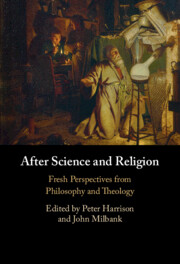Book contents
- After Science and Religion
- Reviews
- After Science and Religion
- Copyright page
- Contents
- Contributors
- Acknowledgements
- Introduction
- Part I Modern Historians on ‘Science’ and ‘Religion’
- Part II Beyond ‘Science and Religion’
- Chapter 3 Science and Theology
- Chapter 4 Religion, Science and Magic
- Chapter 5 Science, Beauty and the Creative Word
- Chapter 6 Questioning the Science and Religion Question
- Chapter 7 Truth, Science and Re-enchantment
- Chapter 8 Understanding Our Knowing
- Part III Philosophical Problems with ‘Science’ and ‘Religion’
- Part IV Before Science and Religion
- References
- Index
Chapter 3 - Science and Theology
Where the Consonance Really Lies
from Part II - Beyond ‘Science and Religion’
Published online by Cambridge University Press: 05 May 2022
- After Science and Religion
- Reviews
- After Science and Religion
- Copyright page
- Contents
- Contributors
- Acknowledgements
- Introduction
- Part I Modern Historians on ‘Science’ and ‘Religion’
- Part II Beyond ‘Science and Religion’
- Chapter 3 Science and Theology
- Chapter 4 Religion, Science and Magic
- Chapter 5 Science, Beauty and the Creative Word
- Chapter 6 Questioning the Science and Religion Question
- Chapter 7 Truth, Science and Re-enchantment
- Chapter 8 Understanding Our Knowing
- Part III Philosophical Problems with ‘Science’ and ‘Religion’
- Part IV Before Science and Religion
- References
- Index
Summary
The estrangement and frequent mutual incomprehension existing between theology and the sciences today reflects chiefly cultural phenomena, arising from particular methodological determinations reached by both disciplines in early modernity that, over time, mutated into irreconcilable metaphysical visions. What had been distinct modes of inquiry within a unified intellectual pursuit of a single comprehensive transcendent truth now came to be understood as entirely unrelated bodies of factual knowledge pursuing separate ends. This change, however, involved several logically unsustainable revisions of previous categories: ‘revelation’, ‘science’, and ‘nature’, for instance, and ‘causality,‘ in particular. Yet these developments imposed limits upon both theology and the sciences that inhibited the power of either to understand many of its own claims. Lately, in physics and the life sciences especially, there has been a healthy movement away from purely mechanical models of causality. Whether theology can recover a dimension of scientifically informed natural philosophy is yet to be seen. But if the two cultures can be disencumbered of their early modern metaphysical prejudices, they might find that they naturally converge upon a shared horizon of ultimate explanation that provides each with its animating logic and reveals each to be only a limited mode of that final wisdom.
Keywords
- Type
- Chapter
- Information
- After Science and ReligionFresh Perspectives from Philosophy and Theology, pp. 61 - 74Publisher: Cambridge University PressPrint publication year: 2022

